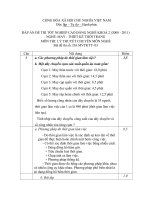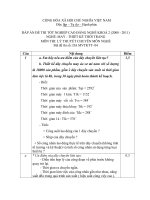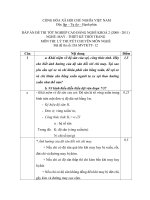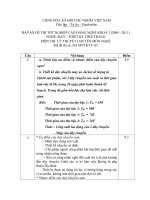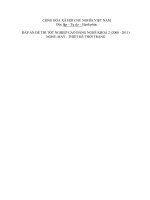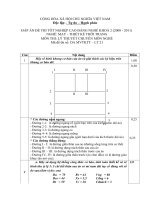Thiết kế thời trang Ebook full English
Bạn đang xem bản rút gọn của tài liệu. Xem và tải ngay bản đầy đủ của tài liệu tại đây (24.6 MB, 178 trang )
BASICS
FASHION DESIGN
05
John Hopkins
FASHION
DRAWING
n
a popular or the latest style
of clothing, hair, decoration
or behaviour
v
to produce an image by
making lines and marks
on paper
BASICS
FASHION DESIGN
05
FASHION
DRAWING
John Hopkins
An AVA Book
Published by AVA Publishing SA
Rue des Fontenailles 16
Case Postale
1000 Lausanne 6
Switzerland
Tel: +41 786 005 109
Email:
Distributed by Thames & Hudson (ex-North America)
181a High Holborn
London WC1V 7QX
United Kingdom
Tel: +44 20 7845 5000
Fax: +44 20 7845 5055
Email:
www.thamesandhudson.com
Distributed in the USA & Canada by:
Ingram Publisher Services Inc.
1 Ingram Blvd.
La Vergne TN 37086
USA
Tel: +1 866 400 5351
Fax: +1 800 838 1149
Email:
English Language Support Office
AVA Publishing (UK) Ltd.
Tel: +44 1903 204 455
Email:
Copyright © AVA Publishing SA 2010
All rights reserved. No part of this publication may be reproduced,
stored in a retrieval system or transmitted in any form or by any means,
electronic, mechanical, photocopying, recording or otherwise, without
permission of the copyright holder.
ISBN 978-2-940411-15-3
10 9 8 7 6 5 4 3 2 1
Design by Sifer Design
Cover illustration by Cecilia Carlstedt
Production by AVA Book Production Pte. Ltd., Singapore
Tel: +65 6334 8173
Fax: +65 6259 9830
Email:
All reasonable attempts have been made to trace, clear and credit the
copyright holders of the images reproduced in this book. However, if any
credits have been inadvertently omitted, the publisher will endeavour to
incorporate amendments in future editions.
2/3
1
1
Illustration by Lovisa Burfitt.
Contents
Introduction
6
How to get the most out of this book
8
Drawing to communicate
your ideas
10
A brief history
Art supplies for drawing
The fashion sketch
Working drawings
Sketchbooks
Interviews
Elmaz Hüseyin
Lovisa Burfitt
12
20
24
30
36
42
44
The fashion figure
Understanding fashion
proportions
Drawing from life
Creating poses
Fashion heads,
faces and hair
Arms, hands,
legs and feet
Drawing men
Fashion Drawing
Interview
Howard Tangye
48
Technical drawings
78
80
84
60
Understanding garments
Drawing fashion flats
Drawing technical
specifications
Vector graphics
and bitmaps
90
66
70
Interview
Tomek Sowacki
94
50
52
56
74
88
4/5
Colouring and rendering 96
Presentation formats
120
Fashion portfolios
Colour for fashion
Fabric rendering
Collage and mixed media
Digital colouring
and rendering
98
104
110
Fashion illustration
Presentation boards
Digital presentations
122
126
134
What is a fashion portfolio? 150
Digital portfolios
154
112
Interviews
Cecilia Carlstedt
Luis Tinoco
Sandra Suy
116
156
136
140
144
Conclusion
160
Templates
162
Further resources
166
Acknowledgements and picture credits
168
Working with ethics
169
Contents
Interview
Petra Börner
Interview
Stephanie Finnan
148
Introduction
6/7
1
‘ I don’t know where I’m going until I actually sit down
and draw.’
Fashion designer and
illustrator Lovisa Burfitt
describes her drawing style
as ‘very fast and restless’.
Jean Muir
Drawing may be described as an evolutionary process that
is fundamental to communicating ideas. This is also true of
fashion drawing, with its distinctive nuances and associations
with style. The exciting breadth and diversity of what
constitutes fashion drawing today is testimony to the
creative vision of fashion designers and fashion illustrators
alike. It reflects the range and scope of media now available,
from a simple graphite pencil to sophisticated CAD programs.
Basics Fashion Design: Fashion Drawing provides a visually
orientated introduction to the different drawing styles,
techniques and approaches that are taught at colleges and
used extensively in the fashion industry. The first part of the
book addresses the basic principles of good fashion drawing,
including the importance of the ubiquitous fashion sketch in
communicating an idea. Understanding fashion proportions in
relation to the anatomy of the standing figure is considered in
chapter two. The following chapter introduces the distinctive
nature and purpose of fashion ‘flats’ and the linear drawing
processes of individual garments. The role of computers to
support and enhance the drawing process is also considered
and compared to more traditional hand-rendering techniques.
The second part of the book covers drawing enhancements,
including colour rendering as an important aspect of fashion
artwork, collage and mixed media techniques. Finally, fashion
drawings for presentation formats and fashion portfolios are
explained and visually illustrated.
1
Introduction
Perhaps the most defining characteristic of the fashion
drawing process, and particularly the fashion sketch, is that
it should enable the designer or illustrator to express him or
herself. It should give rise to a personal drawing style, much
like we have our own handwriting styles. Drawing can take
time to establish and a lifetime to perfect. However, it’s worth
perfecting and it does get better with practice!
How to get the most out of this book
This book is a visually orientated introduction to fashion drawing
and illustration. Each chapter provides numerous examples of the
different drawing styles, techniques and approaches that are taught
on fashion courses and used within the industry.
Throughout the book there are interviews with talented designers
and illustrators, each of which offers a different perspective on
drawing styles as well as an insight into the fashion industry.
Clear navigation
Each chapter has a clear
heading to allow readers
to quickly locate areas of
interest.
Captions
These provide image
details and commentary
to guide the reader in the
exploration of the visuals
displayed.
20 / 21
Drawing to communicate your ideas
Art supplies for drawing
Pencils and charcoal
Setting up your workspace to enable you to draw is a fundamental
starting point. You should always begin by considering your light
sources: make sure that you can see what you are doing. Some
people draw on a flat surface but it is worth considering whether to
raise your sketchbook or paper off the table and arrange it into an
easel position. This should also free up your arms, which is always
the best way to approach drawing. Arranging your art supplies on
the same side as your drawing hand will help to reduce unnecessary
stretching, and helps avoid simple accidents such as dripping paint
on your drawing. Finally, relax and enjoy the experience.
1
Example of working
desk space.
Pencils are among the most versatile
and widely used drawing tools for
designers and fashion students alike.
They are available in a wide range
of grades, but most people work
within the 2H, H, HB and 2B range.
Each grade offers a different density
and line quality. The harder grade
pencils can be useful for producing
fine-detailed line drawings, while the
softer grades are well-suited to more
expressive sketch drawings and
adding tonal values. It’s always worth
experimenting with pencil drawing,
especially when starting out. Pencils
are well-suited to most papers and
holding positions; they may be
sharpened and adjusted and their
lines can easily be erased.
Charcoal is useful for fashion lifedrawing. Drawing with charcoal is
a much looser experience than
working with pencil since it offers
bolder lines that are not intended
to be erased. It is a good media for
loosening up and drawing on larger
paper sizes. Newsprint is well-suited
for charcoal, allowing its deeper tonal
values to come through.
Fashion Drawing
Drawing to communicate your ideas
A brief history > Art supplies for drawing > The fashion sketch
1
Examples
Imagery accompanying
the content, visually
describing fashion
drawing styles and
techniques.
Introductions
Special section introductions
outline basic concepts that
will be discussed.
8/9
Headings
These enable the reader to
break down text and refer
quickly to topics of interest.
Additional information
Box-outs elaborate on
techniques discussed in
the main text.
102 / 103
Colouring and rendering
Colour forecasting
Selecting colours – or, more
specifically, the right colours for a
particular season – is crucial in the
fashion industry and can mean the
difference between success and
failure in terms of a label’s image and
sales. Fashion designers will often
visit their suppliers to discuss colours
for the coming season and will work
closely with their textile partners to
develop ‘lab dips’ and ‘strike-offs’ for
printed textiles. Additionally, the
global fashion industry is served by a
network of trend and fashion
forecasting companies that provide
detailed colour analysis, colour
direction and market-trend research
for fashion and interiors up to two
years in advance of the selling
season. Companies such as
1–8
Trendstop, Peclers, Li Edelkoort for
Trend Union and Promostyl, among
others, are well-respected authorities
on colour, each producing a variety
of specialist reports for their fashion
clients. They also employ fashionorientated illustrators who contribute
to their publications with hand-drawn
illustrations alongside CAD artwork
and colour presentation flats.
Colour forecasting and
catwalk trend images from
Trendstop.
Lab dips
A process whereby a fabric
swatch is test dyed to meet
an exact colour standard.
Lab dips are reviewed in a
light box under controlled
lighting conditions and
may be analysed with a
spectrometer.
Strike-offs
A strike-off is a small run of
screen-printed fabric, which
is used to test the integrity of
the screen for accuracy and
colour trueness. It also refers
to fabric that is printed in
new colours or on new
grounds with existing screens
before a production run.
1–2
4
Chapter titles
These run along the bottom
of every page to provide clear
navigation and allow the reader
to understand the context of
the information on the page.
7–8
Running footers
Clear navigation allows the
reader to know where they
are, where they have come
from and where they are
going in the book.
How to get the most out of this book
3
Colour for fashion > Fabric rendering
Colouring and rendering
5–6
Drawing to communicate your ideas
10 / 11
1
‘ For me drawing is the magic connection between
inspiration and expression.’
Line-up illustration by
Gudrun Kloepsch.
Jean-Charles de Castelbajec
Drawing starts with imagination before it expresses itself as
a practical means of generating or communicating an idea.
In fashion this can manifest itself in a variety of ways that
are linked to social, artistic and cultural values or influences.
This chapter briefly traces the origins of fashion drawing
since the late 19th century to its contemporary expression as
the modern fashion sketch. The techniques and available art
supplies are considered in relation to how fashion drawing
has evolved over time as a hand-rendered practice. The
sketching process and purpose of sketchbooks are also
considered and visually presented to include examples of
working drawings and rough sketches, which are taken
from a variety of contemporary sources.
1
Drawing to communicate your ideas > The fashion figure
This chapter also includes interviews with a commercial
fashion designer and an accomplished designer and
illustrator to gain additional perspectives on fashion
drawing styles, media choices and personal inspirations.
Drawing to communicate your ideas
A brief history
Pochoir
A labour-intensive process
that was popular in France
in the early 20th century,
pochoir involved creating a
colour print with a series of
stencils in which each colour
was vividly applied by hand.
The numerous stencils had
to be carefully placed in order
to apply the individual paints
(watercolour, gouache, ink)
for colour separation.
Gouache
A type of paint that consists
of pigment suspended in
water. Gouache differs from
watercolour in that the
particles are larger and the
ratio of pigment to water is
much higher. It also contains
chalk, which makes it heavier
and more opaque, with
greater reflective qualities.
From the mid-19th century onwards fashion-interest publications
such as La Mode Illustrée, Gazette du Bon Ton and Modes de Paris
published increasingly sophisticated fashion plates of the styles that
emanated from Paris. These drawings became important cultural
markers of fashion in their own right and began to influence the
aesthetic view of dress styles, as well as to communicate the
‘looks’ of the day to their readers.
During the late 19th century, Parisian couturiers such as Charles
Frederick Worth began to sketch their ideas for private clients.
Typically these early examples of fashion drawings aimed for
proportional realism, with the garment rendered in great detail.
Drawing to communicate your ideas
Tempera
Tempera is a type of paint
made by mixing powdered
pigments with egg yolk.
When dry, it produces a
smooth, matt finish.
1
2
12 / 13
At the turn of the century, while
the prevailing look of the day was
controlled by the constricting
S-shaped corset, one notable
illustrator with a distinctive drawing
style defined a look that was referred
to as the ‘Gibson Girl’. His name was
Charles Dana Gibson and his prolific
pen-and-ink drawings were widely
published and admired. Gibson
portrayed an elegant, yet slightly
aloof woman who has been variously
described as taller, more spirited but
altogether feminine.
Following the extreme hourglass
silhouette at the turn of the century,
fashion details focused on the bust
line; the introduction of the sheath
corset influenced a new, more
elongated silhouette. Fashion
drawings were inspired by the
art nouveau movement, with
an added infusion of theatrical
influences and the spectacle of
the touring Ballets Russes.
3
1920s
In 1908, couturier Paul Poiret
commissioned the young print maker
Paul Iribe to draw his gowns for Les
Robes de Paul Poiret, published in
1909. Using the pochoir process,
Iribe applied his vibrant colours to
each print using stencils for each
colour. It was the first time a
couturier had looked to modern
art to represent his creations and
it redefined fashion illustration.
Watercolour, gouache and tempera
were all used during this period as
drawings took on a more ‘painterly’
approach. Watercolour paper or
lightweight card was frequently
used to prevent the water-based
media from buckling the paper. The
resulting fashion plates presented
vibrant colours and linear clarity.
During the 1920s the drawing
style became more angular and
linear in presentation, consistent with
the changing silhouette and artistic
move towards art deco. The new,
‘boyish’ figure appeared longer and
leaner than before as the prevailing
fashions changed.
Drawings began to reflect a frivolity
as the new ‘flapper’ silhouette took
centre stage. With the corset
abandoned, fashionable women
bound their breasts and wore simple
slips as the waistline relaxed to hip
level. The Japanese kimono became
an important stylistic influence and
beadwork and fringing often adorned
the otherwise simple shapes.
Watercolour and gouache media
remained popular, while designers
continued to apply fine-line ink or
pencil to their work for definition
and detail.
1
Example of a Gibson Girl
illustration by Charles
Dana Gibson.
2.
Fashion plate by Paul Iribe
from Les Robes de Paul
Poiret, 1909.
3.
Fashion plate by George
Barbier from Gazette du
Bon Ton, 1922.
A brief history > Art supplies for drawing
1900s–1910s
Drawing to communicate your ideas
1930s
As the exuberances of the
1920s gave way to the sobriety of
the 1930s, the fashion silhouette
became more elongated, sensual
and feminine. Drawing styles
reflected the new mood, becoming
softer and more textural, while
proportions returned to a more
realistic interpretation. The surrealist
art movement influenced fashion
illustration styles during this period,
with some notable collaborations
between fashion couturier Elsa
Schiaparelli and artists such as
Salvador Dalí and Christian Bérard,
with whom she developed ‘shocking
pink’ for one of her collections.
Drawings took on a more lifelike
appearance and the popularity
of bias cutting in rayon and silk
contributed to a softer, almost
slouchy silhouette. The emphasis
on back detailing during this time,
particularly on dresses, was reflected
in the drawings; draping and surface
patterns were rendered in inks,
watercolours and gouache. Brush
strokes became noticeably more
enhanced and were used to great
effect, in combination with colour
washes, to soften the overall look.
Women’s make-up was becoming
more important as new face
powders, mascaras and lipstick
colours were developed and
represented in the drawings,
which exuded Hollywood glamour.
1
Fashion plate by Vionnet
from the 1930s.
2.
Fashion plate by Chanel
from the 1930s.
3.
Christian Dior’s New Look
from the 1940s.
Drawing to communicate your ideas
1
2
14 / 15
1940s
The austerity of the early 1940s saw
another shift in the silhouette, with
hemlines shortening, hats taking on a
new significance and shoulder pads
adding emphasis to a squared-off
shoulder-line. Utility dressing and
‘make do and mend’ became
practical necessities. The scarcity of
resources during the Second World
War was reflected in a more realistic
drawing style. Watercolour and
gouache were still widely used to
render accurate representations of
fabrics, colours and prints. Shadow
wash effects were sometimes added
to enhance the visual composition.
3
A brief history > Art supplies for drawing
The introduction of Christian
Dior’s New Look in 1947 changed
everything and heralded a new
femininity. Drawing styles became
more romantic, with bolder, more
expressive lines. Designers began
to add fabric swatches and
positioned the female figure
centrally on the page.
Drawing to communicate your ideas
1950s
At the start of the 1950s women
continued to wear variations of
the New Look, with its emphasis
on the small waist and full skirt.
Gradually this gave way to different
skirt silhouettes, including the
new bubble skirt and the leaner,
sophisticated pencil skirt. Strapless
cocktail dresses were also popular,
worn with structured foundation
garments to control the silhouette.
This style was accented by the
new stiletto heel.
Drawings of this period, handled
deftly through brush stroke and
bold colour wash effects, exuded
sophistication and elegance.
Watercolour, gouache and inks were
all used by designers and illustrators
during this time. Towards the end of
the 1950s bouffant hairstyles came
into fashion and began to appear
in sketches.
Drawing to communicate your ideas
1
1
Fashion plate of red coat
from the 1950s.
2.
Fashion sketch from the
1960s.
16 / 17
1960s
The 1960s gave full expression
to youth-orientated pop culture
as it swept across the pages of
magazines, challenging the status
quo and redefining accepted ideals
of beauty. Quick-drying, felt-tipped
marker pens were introduced during
this time and were quickly adopted
by designers. The effect on drawings
was immediate and lasting as the
new pens allowed sketches to take
on a more spontaneous and
energetic look. The new fashion
model was portrayed as youthful and
vigorous. Poses changed from being
demure and sophisticated to spirited
and hedonistic as they projected a
new type of freedom for women.
Instead of elegant brush strokes and
back washes, drawings took on a
more linear, geometric expression,
enabled by the new felt-tipped pens.
Mixed media drawings appeared,
which used combinations of marker
pens, pencil, crayon and watercolour.
A brief history > Art supplies for drawing
2
Drawing to communicate your ideas
1970s
Fashion photography gained in
popularity and magazines were
increasingly featuring photographs
over fashion illustrations. Despite this,
drawing styles were still changing
and progressively evolved towards
decorative and psychedelic
expression. Felt-tipped marker pens
continued to be used by designers
in an expanding range of colours.
Drawings became more experimental
and the fashion figure began to be
rendered in the more abstract form
that we recognise today, with
elongated arms and legs in sinuous,
curved poses.
Drawing to communicate your ideas
1
1
Fashion sketch by Louis
Dell’Olio, 1973.
2.
Illustration of Montana dress
by Richard Rosenfeld, 1983.
18 / 19
1980s–1990s
The 1980s saw a renewed interest
in fashion illustration as magazine
editors began to commission
illustrators rather than photographers
for some of their features. It was
a deliberate decision in favour of
rediscovering the uniquely expressive
qualities that a drawing can convey.
It also demonstrated a more inclusive
approach to the broader visual
language of fashion as illustrators
continued to experiment with media.
While designers were still using
felt-tip and marker pens, illustrators
rediscovered watercolour and
gouache as well as colour pencils,
acrylic paints, hard and soft pastel
crayons, charcoals and a variety
of inks.
The late 1980s saw the introduction
of the first CAD (computer-aided
design) imaging software programs.
These had a major impact on fashion
illustration and drawing presentation
formats during the 1990s and into
the new millennium. At first the
new software programs were
used to create background effects
or simply to apply colour blocking to
a drawing. However, as the scope of
applications and editing properties
became recognised by designers
and illustrators, CAD-enhanced
illustrations and drawings began
to exert their influence and expand
the aesthetic view of fashion.
2
A brief history > Art supplies for drawing
Today, fashion drawings are as
diverse as illustrators’ imaginations,
yet they still serve as a distinctive
statement of style.
Drawing to communicate your ideas
Art supplies for drawing
Setting up your workspace to enable you to draw is a fundamental
starting point. You should always begin by considering your light
sources: make sure that you can see what you are doing. Some
people draw on a flat surface but it is worth considering whether to
raise your sketchbook or paper off the table and arrange it into an
easel position. This should also free up your arms, which is always
the best way to approach drawing. Arranging your art supplies on
the same side as your drawing hand will help to reduce unnecessary
stretching, and helps avoid simple accidents such as dripping paint
on your drawing. Finally, relax and enjoy the experience.
Drawing to communicate your ideas
1
20 / 21
Pencils and charcoal
Example of working
desk space.
Pencils are among the most versatile
and widely used drawing tools for
designers and fashion students alike.
They are available in a wide range
of grades, but most people work
within the 2H, H, HB and 2B range.
Each grade offers a different density
and line quality. The harder grade
pencils can be useful for producing
fine-detailed line drawings, while the
softer grades are well-suited to more
expressive sketch drawings and
adding tonal values. It’s always worth
experimenting with pencil drawing,
especially when starting out. Pencils
are well-suited to most papers and
holding positions; they may be
sharpened and adjusted and their
lines can easily be erased.
Charcoal is useful for fashion lifedrawing. Drawing with charcoal is
a much looser experience than
working with pencil since it offers
bolder lines that are not intended
to be erased. It is a good media for
loosening up and drawing on larger
paper sizes. Newsprint is well-suited
for charcoal, allowing its deeper tonal
values to come through.
A brief history > Art supplies for drawing > The fashion sketch
1
Drawing to communicate your ideas
Coloured pastels
Drawing to communicate your ideas
These broadly describe a family
of pastels that includes soft pastels,
hard pastels and oil pastels. Made
from ground colour pigment
combined with gum, soft pastels
are available in a variety of vibrant
colours and graduated tints. They
can sometimes feel slightly crumbly
in the hand but are blendable and
leave a soft, almost creamy mark
on paper. Hard pastels are firmer
to the touch. These are suitable for
producing broad, flat areas of colour
as well as finer lines. Chalk pastels,
which are made up of limestone with
added pigment, are tonally lighter
than pure pigment pastels and
require a fixative to prevent
smudging. Chalk pastels are
sometimes used for fashion
life-drawing as an alternative to
charcoal and are also available in
pencil form. Perhaps less used in
fashion, oil pastels do not require a
fixative and characteristically produce
a thick buttery mark. They can be
used on oil painting paper and may
be dissolved with turpentine to
create softer smudged colours.
Inks
Paints
Chinagraph pencils
Inks were much used in the early
20th century to produce black or
colour drawings and they still
offer a distinctive colour media
choice. They can be applied with
brushes or nibs and are available
in a wide range of colours that can
be mixed to produce almost any
hue. It’s important to differentiate
between inks that are water-soluble
and waterproof. Both can be used
to create wash effects, although
water-soluble inks tend to sink into
the paper and dry to a matt finish.
Adding water will dilute the ink further
and create lighter tones. Waterproof
Indian inks are popular with some
fashion illustrators and can be used
to create line and wash effects
across a variety of paper surfaces.
The most widely used paints
for colour fashion drawings and
illustrations are watercolour and
gouache, both of which are
water-soluble. Watercolour paints
are enduringly popular as they
offer soft, subtle colour washes
and translucent colour effects.
Watercolours can be mixed with
colour pencil to good effect but
should be allowed to dry beforehand.
It’s best to apply watercolour as a
wash without going over it too
much as it is not intended to
produce an opaque surface.
Good-quality watercolour paints
have been developed to eliminate
hard edges. Gouache is an opaque
watercolour paint and is suitable for
laying down a flatter, more even and
opaque colour. Conversely, it is
sometimes watered down but
this is not how it should be applied.
These hard wax pencils are also
known as china markers or grease
pencils. Originally developed for
marking on glossy, non-porous
surfaces such as glass, plastic and
other glazed surfaces, these versatile
pencils also work well on newsprint
paper for figurative drawing and
sketching. The lines they make are
bolder than regular pencils and
suitable for mark making. Although
mostly available in black they do
come in a limited range of colours.
22 / 23
Here are some of the main
choices of paper for fashion
designers and illustrators.
1
1
The desk of illustrator
Richard Haines.
Cartridge papers may have
smooth or fine grain finishes
and are usually offered for sketch
pads in typical sizes from A5 to
A3. While the paper is well-suited
to pencils, soft pastels and most
marker pens it is not ideal for
watercolours. If in doubt, ask
when you buy the paper or
simply experiment with your
chosen media on a small piece.
Watercolour papers are
designed for applying watercolour
and gouache paints. They come
in cold pressed and rough
surface textures, which makes
the paper suitable for holding
water. Hot pressed papers are
used for lighter watercolour
washes and are also excellent for
charcoal drawing and pastels.
Layout paper is often used by
designers and fashion students
for producing line-up sheets or
working drafts of technical
drawings. This semi-opaque
paper is crisp, lightweight and
its smooth surface makes it
suitable for pencil and
pen-and-ink artwork.
Tracing paper is a transparent
paper that is designed to be laid
over another surface and used
for tracing through using all types
of pencils and most pens. It is a
design-orientated paper and
pencil lines can be easily erased.
Newsprint is an inexpensive
paper that is suitable for fashion
life-drawing and sketching.
Available on a roll or in sketch
pads, it is a semi-opaque,
lightweight paper with an
off-white cast and is usually
made from recycled fibres. It is
well-suited for applying charcoal,
pencil and chinagraph.
Multi-media paper (known as
vellum in the USA) refers to a
good, all-round paper that is
suitable for multi-media drawings
including pen and ink, marker
pens, pencils and oil pastels.
These papers are available from
most good-quality paper brands.
Marker papers are characterised
by their bleed-proof finishes that
make them specifically suitable
for applying marker pens. They
also have a special coating on
the reverse side to prevent the
markers from soaking through
to the next sheet.
Note: North American paper
sizes are different from the A4
metric system used throughout
the rest of the world. See page
166 for a conversion table.
A brief history > Art supplies for drawing > The fashion sketch
Paper
When choosing paper, there are
a number of points to consider.
First is to establish the right and
wrong side of the paper as this
will affect the look of your chosen
media. The weight and surface
of the paper should also be
considered: hot pressed (HP or
fine) papers have a smooth, hard
surface. This is the smoothest
type of surface and is well-suited
to pen and ink. Cold pressed
(NOT) papers have a slightly
textured surface. Rough
surface papers take on more of
the texture of the paper-making
felt and are dried naturally
without being pressed. Finally,
consider the size of the paper,
which will determine issues of
scale, and the overall quality:
inferior qualities may fade,
discolour or easily tear.
Drawing to communicate your ideas
The fashion sketch
As we can see from the historical fashion drawings earlier in this
chapter, what passes for a fashion sketch has adapted and evolved
over time, reflecting an aesthetic statement of style that is broadly
aligned to the cultural and social values of the day. Since the 1970s,
fashion designers have adopted a wide variety of approaches to the
fashion sketch. Individuality is often applauded and encouraged in
colleges in the pursuit of creative expression through drawing and,
although media choices have expanded and diversified over the
years, the fashion sketch remains one of the most alluring aspects
of realising a personal drawing style.
Drawing to communicate your ideas
An understanding of the human body is integral to fashion sketching,
which is usually the process of drawing the clothed figure on a
stylised human form. To a lay person, fashion sketches can often
appear abstract, energetic or even unfinished, but in fact fashion
sketches serve different purposes depending on their intended use.
A fashion sketch for a pattern maker would normally require a level
of detail and finish that might include line drawings of all the seams,
1

